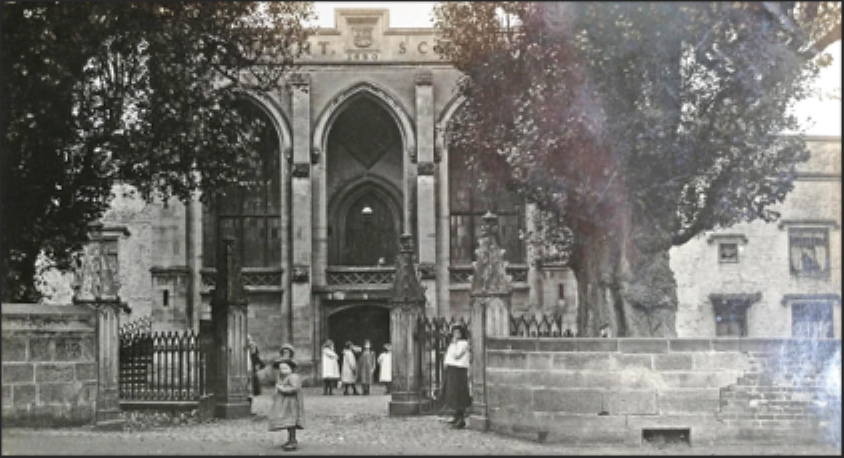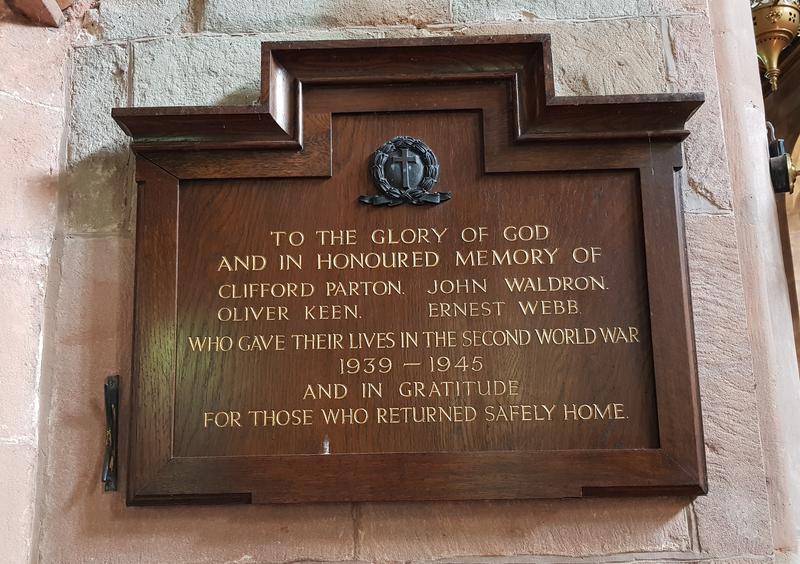
John Henry Waldron was born in 1916, in Kidderminster, Worcestershire. He was the second child of Henry and Florence Waldron – his big sister Queenie was born a couple of years before him.
John’s father was a farmer and the family lived at Lane Farm in Shatterford, Upper Arley.
On completion of his primary education at Upper Arley Church of England School, his parent’s good-standing and John’s obvious academic flair, saw him accepted into Wolverley Grammar School as a dayboy. He studied here between 1927 and 1932 (in Bury Hall House).

In 1931 the school changed its name to Sebright School and moved to a larger site, with local M.P. Stanley Baldwin 'cutting the ribbon' to open the new seat of learning.
Throughout John’s time at Sebright, the school had an extremely well-organised Cadet Force (overseen by a Great War veteran of some standing) and had already earned a reputation for providing keen and energetic young men to serve under the colours. It’s a sad fact, but over the two world wars, some 63 Sebright old boys made the ultimate sacrifice, quite a number for such a relatively small school. The youngest was 17 and the oldest, 43.
About the time that John was leaving Sebright, some of the more ‘savvy’ politicians in Whitehall were beginning to eye the goings-on in Germany with some suspicion. They were clearly concerned that “the war to end all wars” that had been won some fifteen or so years earlier, might not live up to its name…
With concern growing that Europe was on the verge of a second major conflict, in 1936 the Air Ministry decided that the Royal Auxiliary Airforce (the active reserve for the RAF) needed some reserve capability of its own. Hence the Royal Air Force Volunteer Reserve (RAFVR) was formed.
John Waldron was keen to ‘do his bit’ and as a keen aviator, he joined the RAFVR.

When war came, the high demand for aircrew quickly absorbed all available Royal Auxiliary Airforce personnel meaning that the RAFVR automatically became the main entry-point for aircrew joining the RAF.
In its early years, the RAFVR was made-up of civilians who’d been recruited from flying schools and who’d been taught by RAF-trained Instructors in the full range of aircrew 'trades' (wireless operators, observers, gunnery and of course, flying). The trade that John Henry Waldron excelled at, was navigation.
By the end of 1941 more than half of Bomber Command aircrew were members of the RAFVR and as the war dragged on, this figure rose to around 95%. As an RAFVR member himself, John Waldron was eventually assigned to No. 10 Squadron.
Having been extremely active throughout the Great War, completing vital reconnaissance and bombing missions in the battles of Loos, the Somme and Arras, John’s new squadron opened their operational account in World War Two, by dropping leaflets over Germany…
The squadron’s offensive contribution was soon ramped-up however, with bombing raids on Turin and Genoa in June 1940, followed a couple of months later, by raids on the Boulogne dockyards in occupied France.
In December 1941, the squadron upgraded from their outdated Whitley Mk IV bombers and converted to Handley Page Halifax bombers - and on the 19th of August 1942, the squadron was re-located to RAF Melbourne which was located 5 miles to the south-west of Pocklington in Yorkshire.

It was from RAF Melbourne, at 02:57 hrs on the 18th of December 1944, that John and his crew took off in Halifax LV818 – their target: Duisberg, a major logistical and armament manufacturing centre in the heart of the Rhine-Ruhr region of Germany.
The crew of Halifax LV818 that fateful morning were:
~ Pilot: Flight Lieutenant Geoffrey Deller Body, aged 27 – RAFVR
~ 2nd Pilot: Flight Lieutenant Noel Curtis Tatam, aged 26 – RAFVR
~ Flight Engineer: Sergeant Esmond Nicholson, aged 23 – RAFVR
~ Navigator: Flying Officer John Henry Waldron, aged 28 – RAFVR
~ Air Bomber: Pilot Officer William Hewison Leese, aged 20 – RCAF (Royal Canadian Airforce)
~ Wireless Operator/Air Gunner: Flying Officer Douglas John Mole, aged 29 – RAFVR
~ Air Gunner (mid-upper): Sergeant Kenneth Foreshaw Mathews, aged 23 – RAFVR
~ Air Gunner (rear): Sergeant William Ernest Mawson, aged 27 – RAFVR
At approximately 06:00 hrs, while the squadron was flying over the Ardennes region of northern France, for reasons unknown, John’s aircraft collided with another Halifax bomber (NP699 of 432 Squadron, Royal Canadian Air Force, which had flown from a different base but was on the same mission).
Both aircraft plummeted to earth with 14 of the 15 combined air crews being killed.
The only survivor being Flight Officer Max Krakovsky, the Canadian pilot of NP699. He parachuted successfully and landed near Bruly in Belgium.
Following the crash, the bodies of six Bomber Command airmen were discovered by American soldiers and were subsequently interred in an American cemetery at Fosse, near Namur in Belgium.
Shortly after, a further four bodies were found (once again, by American soldiers) and were interred in a different American cemetery – this time in Champigneul in France.
In the early winter of 1945, John’s body was recovered and interred in the Communal Cemetery at Taillette in the Ardennes region of France (around 16 miles north-west of Mezieres and 2 miles north-west of Rocroi, an old fortress town near the Franco-Belgian border).
Three years later, the remains of Flying Officer Douglas Mole were found and buried alongside John in Taillette by the local authorities.
In 1951, the remains of another airman were found near the Ardennes town of Sevigny-la-Foret, which were interred in the local churchyard.
After the war, the six bodies that had initially been buried at Fosse were exhumed, positively identified and re-interred in Leopoldsburg War Cemetery in Belgium. Four of these six were: LV818's Canadian Pilot Officer William Leese, Sergeants Kenneth Mathews and William Mawson and Flight Lieutenant Noel Tatum.
The bodies of the four airmen originally buried in Champigneul were also exhumed but this time, a positive identification could only be achieved on three of them. Two were identified as Royal Canadian Air Force men and were subsequently re-interred in the Canadian Cemetery in Dieppe. The other two - one British, one unidentifiable - were re-interred in Clichy New Communal Cemetery near Paris. Before reburial, the British airman was identified as Sergeant Esmund Nicholson.
In 1953, the body that had been buried two years earlier at Sevigny-la-Foret, was exhumed, positively identified as Flight Sergeant E. Zadorozny (a crewmember of the RCAF Halifax NP699) and re-interred at Choloy Military Cemetery.
The remains of LV818’s pilot, Flight Lieutenant Geoffrey Body, were never recovered (or possibly, they were recovered but never positively identified). He is commemorated on the RAF Memorial at Runnymede near Egham in Surrey.
Today, John Henry Waldron rests in peace alongside his old LV818 aircrew mate Douglas Mole in a kerbed plot. Both have CWGC headstones and a storyboard has been erected behind the airmen’s graves, telling of the tragic events of 18/12/1944.
The storyboard lists the names of the lost airmen from both stricken Halifax's and declares: “Fourteen young men lost their lives in the cause of the freedom of Europe.”

The inscription on John’s headstone reads:
"For God so loved the world that He gave His only begotten son..."
On October the 22nd 2011, a commemorative plaque was added to the local veterans memorial in Rocroi, Belgium. The plaque was funded and erected as a result of the hard work and dedication of Mr. David Mole, the son of LV818’s wireless operator and air gunner, Flying Officer Douglas Mole.

Back in Blighty, John is commemorated in the Upper Arley Church of England School that he attended as a child, and his name also appears on the Upper Arley War Memorial plaque within St. Peter’s Church.


Rest in Peace Flying Officer John Henry Waldron, 1916~1944, Remembered For Evermore.
Footnote: The only survivor of the tragic crash, Max Krakovsky, the Canadian pilot of Halifax NP699, had already completed an impressive 33 sorties before the collision with John’s Halifax – but he nearly died that morning too. When he hit the ground after bailing out, he was surrounded by a group of American soldiers who, on hearing his name, assumed him to be a German dressed as a Canuck in order to spread confusion amongst the ground troops (the Battle of the Bulge was ongoing and this was a ploy the Germans had successfully used before, with tragic results for the Americans). They were about to shoot him as a spy when luckily, one of the Americans who was from Buffalo, quizzed him about Toronto and was convinced of his legitimacy by the answers Max gave. Flight Officer Krakovsky’s service was recognised when he was awarded the Distinguished Flying Cross. After the war he changed his name to Carson, became a family physician and delivered around 2,000 babies!
Acknowledgements: Story content and memorial image ~ the wonderful 'Remember the Fallen' @ www.rememberthefallen.co.uk

